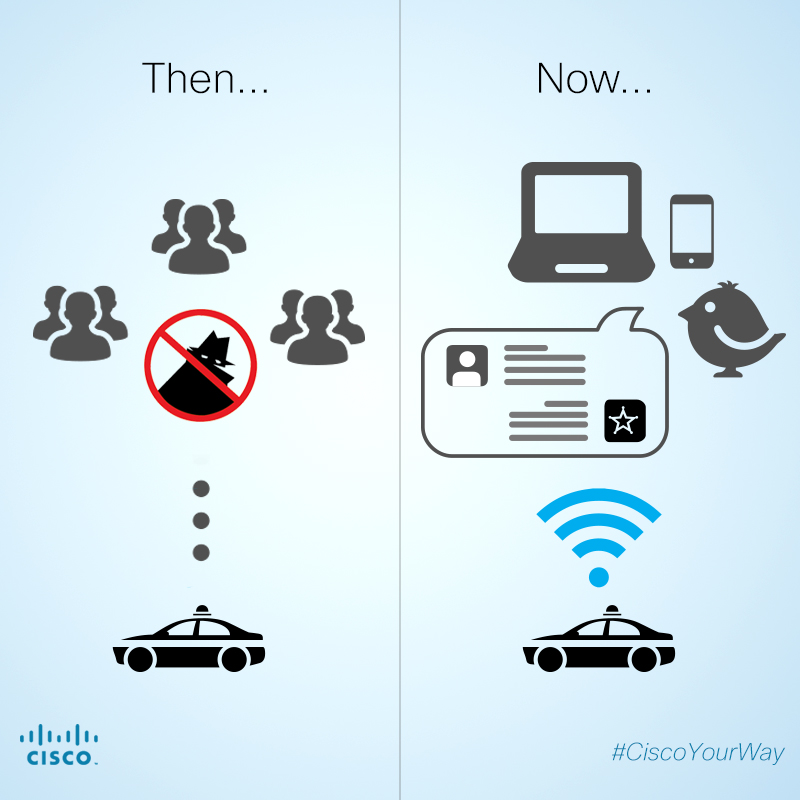Over the last several years, government and law enforcement agencies have increasingly relied on mobile technology to engage citizens and help build a safer community. As we wrap up the public safety blog series, we’ll take a look at how mobility is driving the evolution of smart law enforcement and the role mobility will play in future efforts to serve and protect the public.
How Mobility is Driving Smart, Connected Law Enforcement
Like most industries, the history of law enforcement in America has an interesting story to tell, and it has come a long way thanks to advances in technology. Dating back to the early 1600s when unpaid volunteers kept the “night-watch,” today’s law enforcement officials are keeping communities safe through increased connections, new analytic capabilities and streaming information available at their fingertips.
Here’s a brief look at some early smart policing pioneers and how today’s mobile solutions are driving more connected and efficient law enforcement agencies:
- In 2005, the Leawood, Kansas Police Department implemented a wireless network to a support a mobile-enabled police force. According to an article in Police Chief Magazine, the “network delivers mission-critical information to officers’ in-car laptops, providing such information as outstanding warrants and the location of other police vehicles in the area.”
- In 2007, it was a huge move for police in Zurich to use PCs in their cruisers, a move that greatly improved their ability to stop crime and offer more support for their citizens.
- Recently, a sheriff’s department near Atlanta launched new software to enable law enforcement personnel to analyze crime tip information via mobile device submissions from citizens. Sheriff’s deputies will also be able to take the software into the field via mobile in an effort to reduce crime.
- The Florida Department of Highway Safety installed dashboard cameras in 1,000 patrol cars (to provide video footage as evidence in case of complaints or trials) and antennas in designated parking areas. By deploying access points and antennas throughout the state, the IT team was able to reduce upload times to 20 minutes (compared to three hours previously that was often being paid as overtime to watch an upload). Monetarily, it would have been $1.1 million for the year in overtime due to slow upload times.

Looking at these use cases, it’s clear that when law enforcement officials leverage new mobile solutions, they can spend more time on patrol, which is a key step towards more efficient policing. On the street, having the right information at the right time can make all the difference. Police officers can check plates, run identity searches, capture images, take notes when interviewing suspects and reference agency records. With mobile technology, they can also stay fully informed and handle everyday policing information instead of relying solely on mission critical voice communication and the control room.
Mobility is all about making the officer more efficient and increasing contact and visibility in the community.
Beyond the impact of technology on the individual officer on patrol, technology is also having a transformative impact on law enforcement agencies. Contemporary law enforcement agencies now need to implement technologies to enable expanded communication with officers in the field, to expedite and improve crime reporting and analysis, and to better manage the tactical deployment of forces and strategic utilization of resources like we saw at the 2012 Republican National Convention in Tampa.
Considerations for the Future of Mobile-Enabled Law Enforcement
Technology has empowered officers in the field by giving them the ability to connect to virtually any resource. With the increasing amount of software and apps for law enforcement increasing along with the ability to communicate, agencies must have policy and procedures that match the current mobile technology being used.
As police chiefs and IT managers look for solutions in an increasingly mobile landscape, they are faced with four key challenges, including:
- Budget constraints
- The balance of innovation and operational excellence
- Providing officers with effective and secure mobile collaboration tools
- Securely sharing information within and beyond the dotted jurisdictional lines
Other demands on public safety agencies go beyond the technical realm, such as governance development for interoperability projects. The idea of interoperability is a relatively new concept, requiring a shift in the systemic law enforcement paradigm to become a viable movement. Especially as history shows us that law enforcement agencies have engineered and maintained their respective systems to be independent of neighboring jurisdictions.
Today’s mobile solutions could support interagency connectivity, but an underlying question for many underfunded agencies is that of simply building and maintaining collective effort projects.
With these considerations in mind, it’s important for government agencies to continue to advocate for transformative mobility solutions that can build safer, more informed communities.
Be sure to let us know how you liked this blog series dedicated to public safety and what you want to hear more about via comment below or join the conversation on Twitter, #CiscoYourWay. For additional resources, best practices and insights, check out our State & Local Government Survival Guide or visit our Cisco Government webpage.

Tech has come on strong and getting better. Glad to see all use to make our life saver
Russell Theaker
Senior Systems Engineer Fujitsu Australia